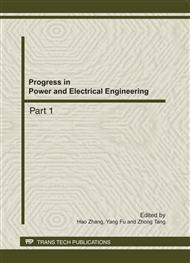[1]
Taylor JamesW, Roberto Buizza. Neural network load forecasting with weather ensemble predictions [J]. IEEE Transaction on Power Systems, 2001, 17(3) : 626-632.
DOI: 10.1109/tpwrs.2002.800906
Google Scholar
[2]
HE Rong, ZENG Gang, YAO Jian-gang, et.al. Application of Weather Sensitivity Neural Network Model in Short-term Load Forecasting on Area [J]. Automation of Electric Power Systems, 2001,25(9): 32-35, 52. In Chinese
Google Scholar
[3]
Yang Zhengling, Tian Yong, Lin Kongyuan. Application of multi-step regression considering climate factors in method synthesizing double period s and chaotic components to short term load forecasting [J]. Power System Technology, 2004, 28(12) : 20-24. In Chinese
Google Scholar
[4]
KANG Chong-qing, ZHOU An-shi, WANG Peng, et al. Impact Analysis of Hourly Weather Factors in Short-term Load Forecasting and Its Processing Strategy [J]. Power System Technology, 2006, 30(7): 5-10. In Chinese
Google Scholar
[5]
Qin Haichao, Wang Wei, Zhou Hui. Short-term electric load forecast by inducting human body amenity [J]. Journal of Electric Power, 2006, 21(2): 143-145. In Chinese
Google Scholar
[6]
HE Jing, WEI Gang, XIONG Ling-ling. Fuzzy Improvement of Linear Regression Analysis for Load Forecasting [J]. East China Electric Power, 2003,( 11): 21-23. In Chinese
Google Scholar
[7]
Nima Amjady. Short-term hourly load forecasting using time-series modeling with peak load estimation capability [J]. IEEE Transaction on Power Systems, 2001, 16(3) : 498-505.
DOI: 10.1109/59.932287
Google Scholar
[8]
Zhang Lin, Liu Xianshan, Yin Hejun. Application of support vector machines based on time sequence in power system load forecasting [J]. Power System Technology, 2004, 28(19): 38-41. In Chinese
Google Scholar
[9]
Cao Guojian, Huang Chun, Long Hui et at. Load forecasting based on improved GM(1,1) Model [J]. Power System Technology, 2004, 28(13) : 50-53. In Chinese
Google Scholar
[10]
Yu Jianming, Yan Fei, Yang Wenyu et at. Gray variable weight combination model for middle and load term load forecasting [J]. Power System Technology, 2005, 29(17): 26-29. In Chinese
Google Scholar
[11]
Zhou Dianmin, Guan Xiaohong,Sun Jie, Huang Yong. A short-term load forecasting system based on BP artificial neural network [J]. Power System Technology, 2002, 26(2): 10-13, 18. In Chinese
Google Scholar


